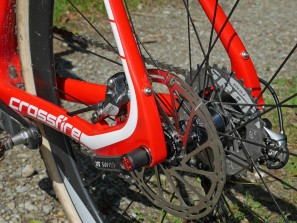With cyclocross season having just gotten underway in the US this past weekend and on the horizon here in Europe, we’ve been looking at cross gear again and what new European bikes are in the pipeline. Earlier in the summer we had a chance to take a look at the new bikes from German company Centurion, one of which was the new Crossfire Carbon Team. At Eurobike we took the opportunity to take the bike out for a test ride on the mix of forest roads and trails just off from the fairgrounds to get a feel for the bike that will also be available under the Merida brand.
Join us after the break for some updated details, and our first impressions…
We first covered the Crossfire Carbon last year when it was just a prototype from Centurion, but this year it has gone into production. As we mentioned back in July, this bike was initially developed as an independent concept by the engineers at Centurion, but during the move to a production bike Merida joined in to help bring it to market. That co-development makes this unique amongst the Merida-Centurion family as it will be the only performance bike to be sold under both brands. That should be interesting to many of our readers, because even though Centurion has a fairly limited market, the Merida side of things brings a lot wider distribution. In fact, from our European base in the Czech Republic the Centurion is not available, but the same frame and fork with a slightly more affordable build should be attainable from Merida. We’re keeping that in mind, as we wouldn’t mind getting the Merida version in for a longer test later this race season.
The Centurion test bike we rode was the same 4800€ Crossfire Carbon Team that we saw at the earlier summer press camp. It is the top of two builds available under the Centurion brand for the new carbon frameset, and is definitely set up to be race ready out of the box. The Team version gets a complete SRAM Force CX1 groupset, with a 40T ring and a Red22 11-32 cassette. (The other bike in the range, the 3400€ Crossfire Carbon 4000, gets a mechanical Ultegra CX double drivetrain. The Merida versions will range from 2300-3500€ with three options, including Shimano doubles and a CX1 build.)
The Crossfire Carbon Team really was ready to race, and comes with supple tubulars glued up from the factory. The cotton casing Challenge Limus 33 Team Edition tubulars are glued to a carbon DT Swiss RC38 Spline T DB wheelset. The bike doesn’t do much corner-cutting to shave weight that would compromise race-reliability, but does get a superlight carbon seatpost clamp that we’d be a bit cautious about after a season of rough remounts. I tested it out a bit with as many remounts as we could squeeze into our test ride, and while the saddle rails creaked once or twice, I didn’t hear anything out of the clamp.
The Team build gets Force CX1 Hydro disc-brakes with 160mm rotors front and rear, with 15x100mm and 12x142mm thru-axles. As the disc-brake cross market struggles to figure out which brake and axle standards to go with the Centurion/Merida solution sticks with what works as carry over from the XC mountain bike side. We obviously didn’t get enough time in one hour or so of riding to turn up any problems here, but it certainly would have been nice if 140mm rotors had been an option.
The Crossfire Carbon Team we rode has a claimed weight of 7.2kg. The actual weight of the 56cm test bike with 280g eggbeater pedals was 7.50kg (16.53lbs), so pretty much on point. A frame and fork kit can also be had for 1400€ at a claimed 1475g (3 1/4lbs), as well as the lesser spec’ed Ultegra bike.
The bike is a full half kilo lighter than the lightest carbon cross bike that we tested last season (the Storck T.I.X.), and the weight really shows. The Crossfire was easy to get up to speed, quick to maneuver, and easy to get over the few obstacles we could find. In our short test the bike seemed appropriately stiff, and at the same time we didn’t come away feeling beaten up after a cross race length test. The stiff DT wheels seemed like a solid match for the bike, while the Challenge tubulars were both familiar and plush, letting me push the bike hard in some good turns to get a feel for this racy bike. It’s easy to underestimate the power of a set of light, stiff wheels wrapped in good tubulars to make a bike feel great. While they make a lot of sense for racing and I could find no fault with the wheels, we’d also be curious to ride the bike with some more mid-range wheels to see how much of the ride feel was actually attributed to the frameset. We’re in talks now to try and get one of the Merida versions in for a test later in the autumn, so we’ll hopefully be able to give that version a proper thrashing to report back after some real race experience.











